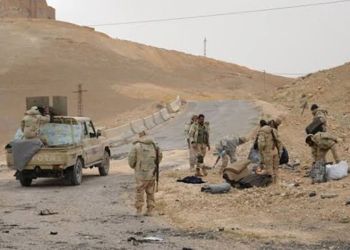This post is also available in:
![]() العربية
العربية
Nowadays, one of the diseases and the most significant problems our societies are facing, whether rich or poor, developed and undeveloped countries, is the inter-continental epidemic and the most lucrative source of income for major mafia gangs; it is drug addiction.
Drug addiction is the result of social religious economic changes taking place in society. The Syrian society is just like any other society in the world that is also undergoing addiction; however, it is still light in its impact and limited to certain categories and groups within our society when compared to others.
Had it not been for the astronomic corruption within the ruling class, drug addictions would never had threatened Syrian society. Drug addictions thrive mainly during times of conflicts and war, where chaos and instability leave the borders of a country open for the smugglers and human traffickers.
The drug dealers are merchants who are opportunists by nature and; therefore, they seize the opportunity during times of conflicts and war to exploit the people and turn their suffering to their benefit. They are heartless and compassionless people who care about no one but themselves. Human suffering or children in need are meaningless and valueless concepts for them. The main rule that governs their lives is how much money they can make out of this.
With the beginning of the Syrian Revolution, the topic of drug addiction was almost nonexistent and therefore, it was not included among the other priorities of the society. People rebelling against the government, hoping that they can get freedom and dignity, were not in a position to turn their focus towards few cases of addictions, while ignoring the ongoing bloodshed caused by the tyrannical regime.
As the peaceful protests shifted to armed uprising, the Assad regime resorted to indiscriminatory shelling using his warplanes and heavy artillery and, as a result, claiming the lives of several civilians, many of whom have suffered mental and physical injuries.
After five years of Syrian armed uprising, it became necessary to look at its results or outcomes. There is now an apparent increase in the numbers of people addicted to drugs in the Syrian society.
Dr Aham, one of the doctors who have been monitoring such cases in the Syrian society after the revolution says, “There is an evident and clear-cut increase with regard to the number of people addicted to drugs in the Syrian society today. This is the case whether we are talking about people addicted to caffeine, morphine or other drugs.”
He continues, ‘’ We can divide the cases of addiction into different categories, and the most suitable way is to split them based on the reason causing this addiction, therefore; there are four reasons that gave rise to this phenomenon in our society.
First reason:
Is mainly due to the ongoing instability and chaotic situation in Syria. The high spread of weaponry and the decrease in surveillance and control of the society. All of these have paved the way for all types of drugs to be easily smuggled into Syria.
The targeted people by this phenomenon are the youth, especially teenagers, as we are all aware of the fact that because of their curiosity they want to try everything. Because of the tough and deplorable conditions the youth are going through in Syria, most of the drugs they take are considered as the cheapest types. Drug addiction cases have also become prevalent in both the liberated areas and Assad-held territory in Syria.
A type of cough medicine was utilized as an alternative to drugs because it contains on a substance called codeine that influences the nervous system, and it has to be taken for a long period exceeding two weeks a month with high doses exceeding ten mg per dose to serve as a substitute for drugs.
Codeine has a sedative and analgesic effect at the same time that eases fever and this is why it is used as a cough medicine.
There are also alternatives to pricey drugs and they are embodied in the sniffing of substances with a pungent aroma, such as alcohol and diesel which turn into gas once they are in contact with the air. They calm down the nervous system that creates an attraction in the mind of the addicted person that forces him to do it repeatedly.
Hashish is also available in wealthy built up areas, mainly those who work abroad and then return with huge amounts of drugs to sell, as there is little to no border control so that smuggling is relatively easy.
Some activists accuse the Assad regime of encouraging this phenomenon of drug addiction among the youth mainly in its occupied territories by making the drugs available, especially hallucinogenic type drugs, in an attempt to make it straightforward and uncomplicated for him to control their minds and therefore conscript them to his ranks.
Some rebels had previously mentioned that behaviors of some of the regime soldiers were unnatural in the battle zone. It is reported that they were careless and stayed firm whilst they were under heavy gunfire or explosions. They were completely out of conscious. When some of them were captured, it became obvious that they were under the influence of drugs. They appeared to be mentally unstable. One of the substances used by the regime soldiers are the pills called valium.
The second reason
The second cause of drug addiction presented by Dr Aham is due to depression that the Syrian society, with all its components, is going through. The Syrian revolution was a window of hope for the Syrian people, hoping for a better future and connecting their freedom with its success. However, the failure of the revolution to secure the stability and attain a quick and real victory, in addition to the long period of this endless war has led the youth to suffer from depression and trauma after becoming pessimistic with the events of conflict.
This was some of the reasons why a group of youth people resorted to taking these substances to escape the bitter reality they are facing. Unfortunately, these cases are also highly spread among those who are prominent in the Syrian revolution including those who are deemed elite in society, such as doctors, engineers and writers. The gap that they had in their lives due to unemployment caused them to become pessimistic and consequently resorting to taking drugs to escape from reality.
The most notable type of drugs taken by these people is hashish because it is done with groups of people and it is a social drug which seals (and cements bonds) the nature of these gatherings.
Syrian people, because of the displacement they were subjected to, ended up living in new, different societies with distinct traditions and moral values and, as a result of this interaction, all of the condition of drug addiction were realized among teenagers and young people. Looking for a better life, feeling like strangers and being fearful of what awaits them in the future.
The new social illnesses are transmitted just like other infectious diseases. The cases of addiction has spread through communities and there are other forms, mainly caused by poverty, such as the sniffing petrol, gasoline, paint, all of which are relatively cheap that commensurate its use and they are also available and are not illegal.
The Fourth Reason
The fourth reason is one of the most important problems and at the same time the most difficult one. It’s the situation where drug addiction is imposed on both the youth and the adults. Sometimes all the different categories within the society. As we know, 200,000 Syrian people have been wounded in indiscriminatory shelling by Assad forces. With regard to how this group of people are subjected to drug addiction is as Dr Hatham tells us.
“All the wounded in this war, many civilians, are transported to field hospitals, which are small hospitals made as an urgent alternative to other hospitals to help rescue as quick as possible those who get injured in war. Most of the wounded people in these hospitals take (are given) painkillers.
The bone injuries and amputation along with nerve wounds, caused by shrapnel, shells and bombings are a type of injury that necessitates a long period of therapy with analgesics, ranging from three months to one year, especially in the case of amputation, which are painful operations.
Most of these painkillers that are given to these patients are tramadol and morphine. All of these substances can lead to addiction when utilized for a long period. It is because of the comfort they brings to the body of the patient. The latter resorts to taking extra doses which causes him to be addicted to it. It’s the turning point where the journey of addiction began because the patient would be in a situation to continue using these painkillers, even if he was recovered from his injuries. His body would be so much in need of these types of substances, pushing the patient to search for this drug and buy them at whatever prices they cost to fulfil the needs of his body.
This category is the most affected within our society and there is no difference between the poor, the rich, the young adult, women or men. Addiction does not distinguish between them in the same manner as bombing and shelling do. Unfortunately, there is no means, at least for the current time, to overcome these rampant afflictions in our society and this is because of the following reasons:
- There is no side in charge of addressing this issue because of the nature of war but as the war is ongoing in Syria and the lack of authority on the ground and the division between the liberated areas, some of which are under regime controls, whilst others are under the rule of multiple factions.
- There is the absence of an institution or international community to adopt this phenomenon because the primary concern with these institutions right now is only to provide support and treatment for the victims of war albeit on a small scale. Such aid does not even equal the tragedy the Syrian people have been going through.
- The patients are afraid of being exposed, especially because the majority of them are living in countries where they are unaware of the law and therefore they are concerned about being treated as drug addicts instead of patients forced due to the circumstances of war to resort to such types of drugs.
The only effective means to get rid of this phenomenon is that the United Nations should adopt a program whose main function is to spread awareness of the danger of drug addiction, and establish medical centers to take care of these patients in the areas where there are Syrian refugees.
Drug addiction is a new illness that has appeared in this ruined society and a new suffering added to the ones that preceded it, including displacement, murder and fear. Maybe we are not aware of the danger its carries and the negative impacts it will have in the future, mainly because it targets the youth that are supposed to be one of the key building blocks to build the new Syria in the future. The alarm bells should start ringing from now so that we can reach radical solutions to it before it is too late.










